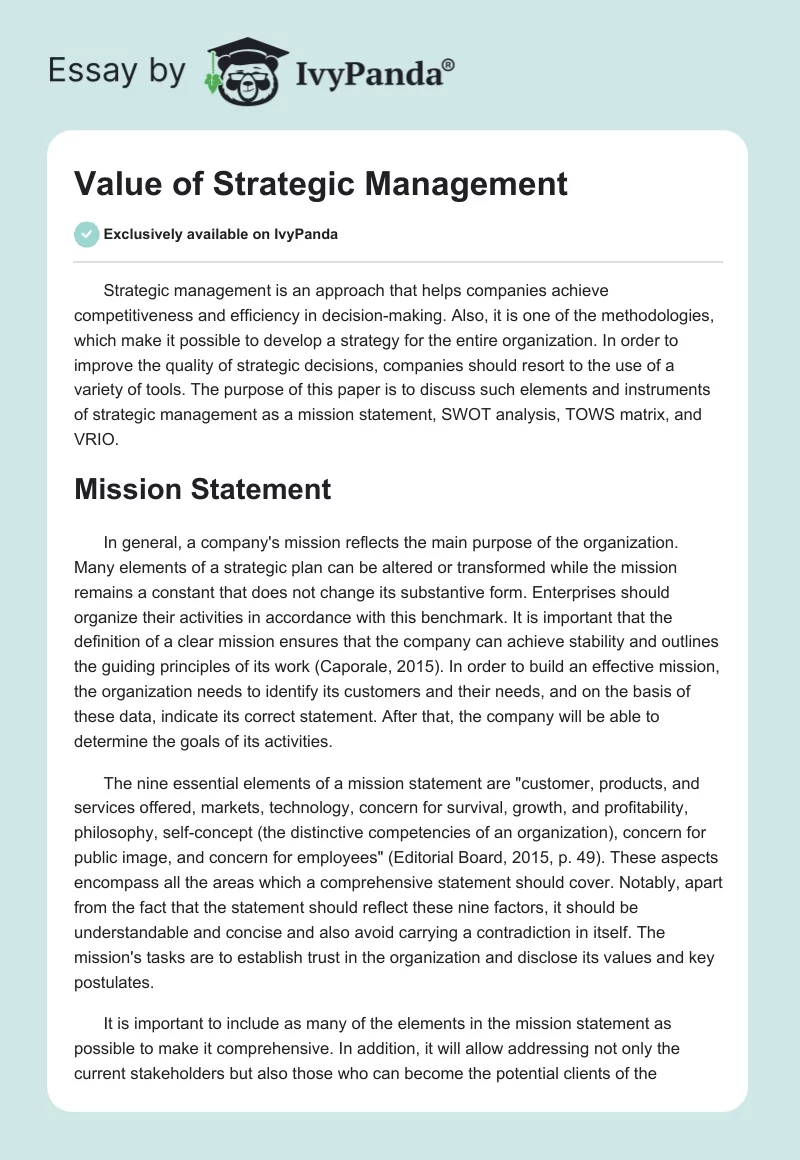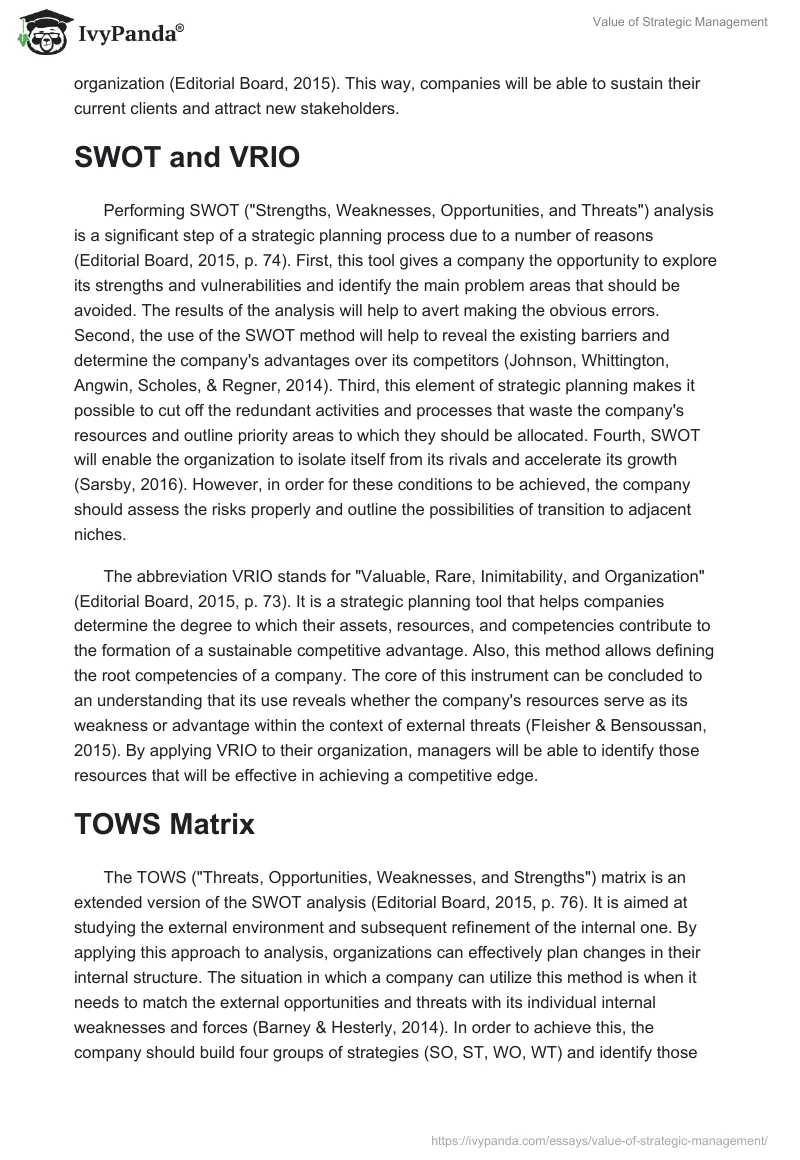Strategic management is an approach that helps companies achieve competitiveness and efficiency in decision-making. Also, it is one of the methodologies, which make it possible to develop a strategy for the entire organization. In order to improve the quality of strategic decisions, companies should resort to the use of a variety of tools. The purpose of this paper is to discuss such elements and instruments of strategic management as a mission statement, SWOT analysis, TOWS matrix, and VRIO.
Mission Statement
In general, a company’s mission reflects the main purpose of the organization. Many elements of a strategic plan can be altered or transformed while the mission remains a constant that does not change its substantive form. Enterprises should organize their activities in accordance with this benchmark. It is important that the definition of a clear mission ensures that the company can achieve stability and outlines the guiding principles of its work (Caporale, 2015). In order to build an effective mission, the organization needs to identify its customers and their needs, and on the basis of these data, indicate its correct statement. After that, the company will be able to determine the goals of its activities.
The nine essential elements of a mission statement are “customer, products, and services offered, markets, technology, concern for survival, growth, and profitability, philosophy, self-concept (the distinctive competencies of an organization), concern for public image, and concern for employees” (Editorial Board, 2015, p. 49). These aspects encompass all the areas which a comprehensive statement should cover. Notably, apart from the fact that the statement should reflect these nine factors, it should be understandable and concise and also avoid carrying a contradiction in itself. The mission’s tasks are to establish trust in the organization and disclose its values and key postulates.
It is important to include as many of the elements in the mission statement as possible to make it comprehensive. In addition, it will allow addressing not only the current stakeholders but also those who can become the potential clients of the organization (Editorial Board, 2015). This way, companies will be able to sustain their current clients and attract new stakeholders.
SWOT and VRIO
Performing SWOT (“Strengths, Weaknesses, Opportunities, and Threats”) analysis is a significant step of a strategic planning process due to a number of reasons (Editorial Board, 2015, p. 74). First, this tool gives a company the opportunity to explore its strengths and vulnerabilities and identify the main problem areas that should be avoided. The results of the analysis will help to avert making the obvious errors. Second, the use of the SWOT method will help to reveal the existing barriers and determine the company’s advantages over its competitors (Johnson, Whittington, Angwin, Scholes, & Regner, 2014). Third, this element of strategic planning makes it possible to cut off the redundant activities and processes that waste the company’s resources and outline priority areas to which they should be allocated. Fourth, SWOT will enable the organization to isolate itself from its rivals and accelerate its growth (Sarsby, 2016). However, in order for these conditions to be achieved, the company should assess the risks properly and outline the possibilities of transition to adjacent niches.
The abbreviation VRIO stands for “Valuable, Rare, Inimitability, and Organization” (Editorial Board, 2015, p. 73). It is a strategic planning tool that helps companies determine the degree to which their assets, resources, and competencies contribute to the formation of a sustainable competitive advantage. Also, this method allows defining the root competencies of a company. The core of this instrument can be concluded to an understanding that its use reveals whether the company’s resources serve as its weakness or advantage within the context of external threats (Fleisher & Bensoussan, 2015). By applying VRIO to their organization, managers will be able to identify those resources that will be effective in achieving a competitive edge.
TOWS Matrix
The TOWS (“Threats, Opportunities, Weaknesses, and Strengths”) matrix is an extended version of the SWOT analysis (Editorial Board, 2015, p. 76). It is aimed at studying the external environment and subsequent refinement of the internal one. By applying this approach to analysis, organizations can effectively plan changes in their internal structure. The situation in which a company can utilize this method is when it needs to match the external opportunities and threats with its individual internal weaknesses and forces (Barney & Hesterly, 2014). In order to achieve this, the company should build four groups of strategies (SO, ST, WO, WT) and identify those ones that are more important. Despite the fact that the use of the extended matrix is more complex than the application of SWOT, the first approach ensures an analysis that will be more comprehensive in scope.
Conclusion
Thus, it can be concluded that organizations should have a clear mission statement that will help them sustain their key stakeholders and attract new ones. In addition, companies should employ various tools for strategic management planning to ensure that they can reach their competitive edge and utilize the existing resources effectively. Such instruments as SWOT, TOWS, and VRIO can assist companies in achieving these aims.
References
Barney, J. B., & Hesterly, W. S. (2014). Strategic management and competitive advantage: Concepts (5th ed.). London, UK: Pearson Education.
Caporale, B. (2015). Creative strategy generation: Using passion and creativity to compose business strategies that inspire action and growth. New York, NY: McGraw Hill Professional.
Editorial Board. (2015). Research methods for strategic management. Schaumburg, IL: Words of Wisdom.
Fleisher, C. S., & Bensoussan, B. E. (2015). Business and competitive analysis: Effective application of new and classic methods (2nd ed.). Upper Saddle River, NJ: FT Press.
Johnson, G., Whittington, R., Angwin, D., Scholes, K., & Regner, P. (2014). Exploring strategy (10th ed.). London, UK: Pearson Education.
Sarsby, A. (2016). SWOT analysis. Morrisville, NC: Lulu Press.


